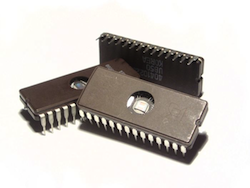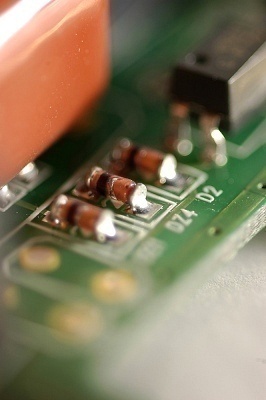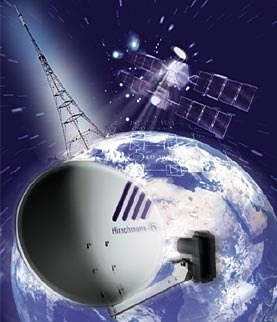An integrated circuit (IC), also called a microchip, is an electronic circuit etched onto a silicon chip. Their main advantages are low cost, low power, high performance, and very small size.
History
The integrated circuit was invented in 1958 by Jack Kirby (1923-2005), an American engineer. In 2000, he won the Nobel prize in physics for his integrated circuit. This basic design has evolved over the last half century to reach the level of the modern computer chip, which has millions of transistors on a thumbnail size piece of silicon.
Manufacturing

Integrated circuits are made using a process called photolithography. A pure crystal of silicone, called the substrate, is placed in a chamber. A thin layer of silicone dioxide is deposited on the substrate, followed by another chemical layer, called a resist. The wafer is then exposed to ultraviolet light shone through a mask of the circuit. Depending on the type of resist, the light either makes it harder or easier to dissolve with the developer solution. This process is repeated many times, resulting in layers of semiconductor devices and conducting tracks. Hundreds of chips are made on each silicone wafer, which are cutout by a laser before being mounted in packages.
Packaging
Integrated circuits are very fragile, and need to be enclosed in a solid package before they can be put on a circuit board. The most common is the dual in-line package, also called DIP or DIL. It is a small plastic block with two rows of pins on the sides. Another form is the pin grid array (PGA), a square block with many pins on the base, used for large computer chips like CPUs.
Markings
The chip name and manufacturer is usually printed on top in white lettering, and there will also be a notch or dot on one edge. Pins on a dual in-line package are numbered counter-clockwise when looking from above, with the notch at the 12 o’clock position. The first pin is at the top-left corner, and the last pin is at the top-right corner.
Uses for Integrated Circuits
Many integrated circuits can be found in almost every electronic device. They function as timers, amplifiers, logic units, counters, calculators, temperature sensors, and radio receivers.
Integrated Circuit Design
Integrated Circuit Design (known as IC design) is a process in computer and electrical engineering in which the engineer designs an integrated circuit. ICs are made up of electronic components that are incredibly small. These components are built into a network on a monolithic semiconductor substrate. The process by which these components are built onto the substrate is through a process known as photolithography which is a process in which parts of a thin film are removed.
The type of IC design can be broken up into two separate categories. The first is digital IC design and the second is analog IC design.

Digital IC Design
Digital IC design is a very complex type of design that is used in the creation of components such as microprocessors, different types of memory (RAM, ROM, Flash), digital ASICs, and FPGAs. The primary focus for an individual that is using digital IC design is on three things. The first is logical correctness. The second is circuit density. The more that can be added to a single circuit, the stronger the chip is going to be. The final thing that an engineer looks at is the placement of the circuits so that the clock and timing systems are as efficient as possible.
Analog IC Design
Analog IC design is a more basic type of design used to create op-amps, oscillators, active fillers, phase locked loops and liner regulators. Unlike digital IC design which is focused on fitting the most into the circuit as possible, analog IC design focuses on the physics of the semiconductor. The big things a designer pays attention to is the gain, matching, power dissipation and resistance of the semiconductor. Typically, an analog IC design uses a much larger area that a digital IC design. More so, they are typically less dense than digital IC designs because they are not about packing as much circuitry in.
In the end, despite what type of design – digital or analog – is being used is irrelevant. The process is the same. A computer engineer is trying to create electrical components on a piece of semiconductor such as silicon.




Anilesh
I have problem about LCD Screen of Compaq v2000